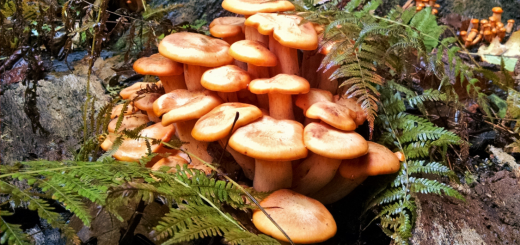#110: Alectoria sarmentosa, Witch’s Hair
This lichen can be found hanging from trees in conifer forests of the Pacific Northwest (Oregon to Alaska). Alectoria sarmentosa is light green, highly branched, and drapes over tree branches like tinsel. This resembles bushy, green hair such as that a witch might have.
A. sarmentosa grows from conifer branches that receive a lot of sunlight and are exposed to wind. This lichen is more resistant to drying out than most lichens, so it does well in upper branches of trees and along forest edges. In those places, Witch’s Hair can form long clumps of strands that stretch for 15-30cm or more. Each strand is highly branched and does not have a central stalk, so the clumps of Witch’s Hair are basically massive tangles of these strands.
Witch’s Hair is a lichen, so it is actually made up of two organisms: a fungus (A. sarmentosa) and an alga. The fungus is the dominant partner in the symbiosis, so the lichen shares the name of the fungus. Morphologically, this lichen is fruticose. That means all the lichen’s structures are branch-like: they are cylindrical and do not differentiate between upper and lower surfaces. Each “branch” of the lichen has an outer protective layer of hyphae. The algae are kept underneath the outer layer, where they have access to air and water but are protected from harsh sunlight. The center of the lichen is composed of fungal hyphae, which gives the lichen rigidity, stores resources, and anchors the lichen.
A. sarmentosa does not produce any special asexual reproductive structures and only rarely produces sexual reproductive structures. Instead, Witch’s Hair normally spreads when pieces break off in storms. These pieces get blown around and land in new trees, where they continue to grow. Many pieces land on the ground, where they are eaten or decompose. This process benefits the forest by returning nutrients to the earth. The fungus occasionally reproduces sexually by producing spores in a disc-shaped structure called an “apothecium.” This mode of reproduction does not bring along the algal symbiont, so it is less likely to produce new, viable lichens. The apothecium contains asci, which are the sexual reproductive cells of ascomycetes. A. sarmentosa belongs to the phylum Ascomycota, class Ascomycetes, order Lecanorales, and family Alectoriaceae.
There are many species of lichen similar to A. sarmentosa in the Pacific Northwest. Most of these are in the Alectoria genus and have common names that are variations on “Witch’s Hair.” A. sarmentosa is the most common of these, so it is often referred to as “Common Witch’s Hair.” Closely related species can be differentiated by color and growth habit using a relevant key. Another genus with similar species is Usnea. Species in this genus are known as “Old Man’s Beard” and can be differentiated by the central cord in their main branches.
Native Americans found a number of uses for Witch’s Hair. Some of these uses included: weaving low-quality clothing and footwear, bedding while camping, hair for ceremonial masks, making fires smoky, wiping salmon, baby diapers, feminine hygiene products, and dressing wounds. These uses take advantage of Witch’s Hair’s branching, absorbent properties, and antibacterial compounds. The lichens can be taken directly from trees or picked up off the ground after storms.
See Further:
http://www.centralcoastbiodiversity.org/common-witchs-hair-bull-alectoria-sarmentosa.html
http://www.lichen.com/bigpix/Asarmentosa.html
http://web.uvic.ca/~stucraw/part2AM.html#Alectoria_sarmentosa








![#011: Characteristics of Kingdom Fungi [Archived]](https://www.fungusfactfriday.com/wp-content/themes/hueman/assets/front/img/thumb-small-empty.png)
